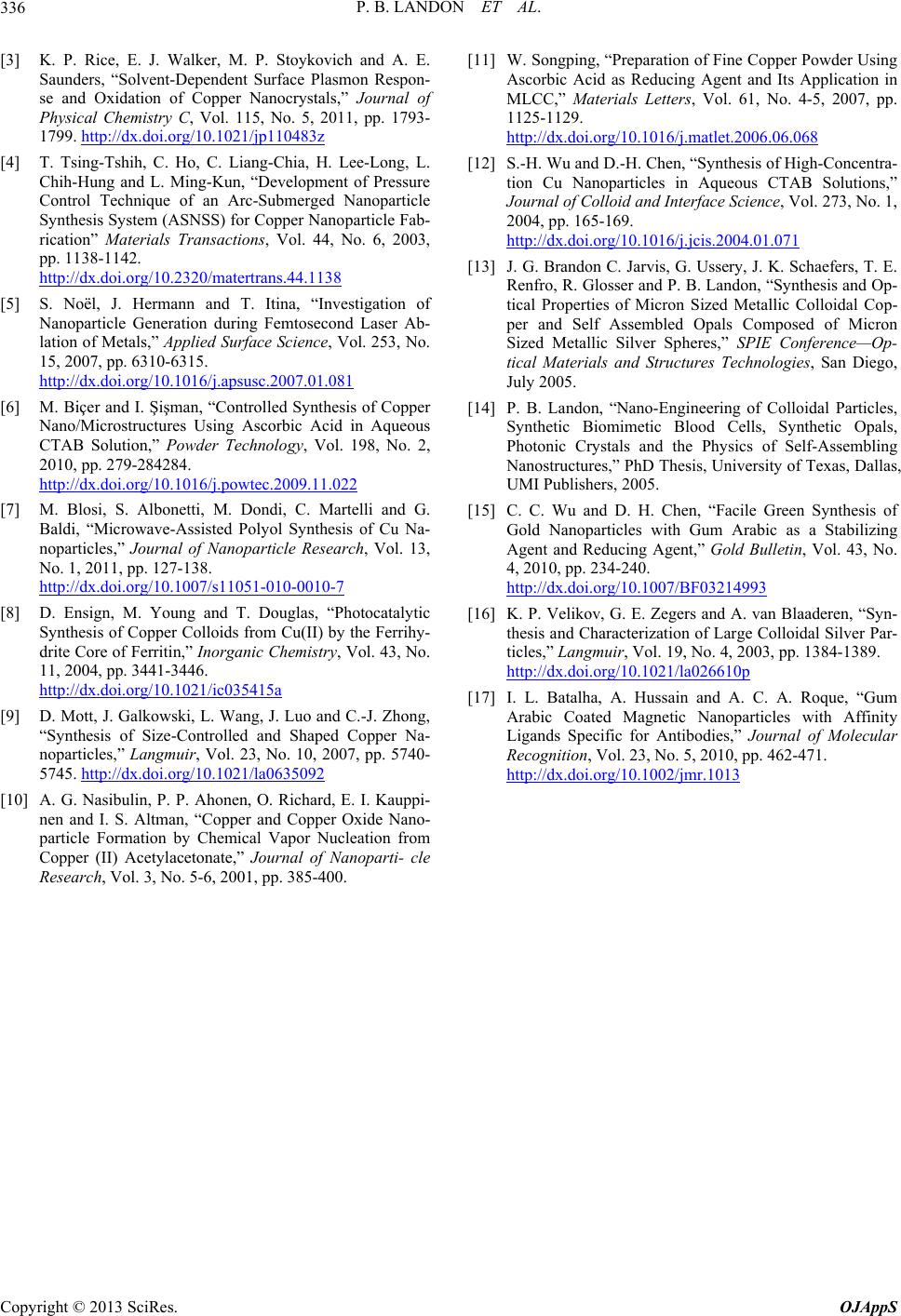
P. B. LANDON ET AL.
336
[3] K. P. Rice, E. J. Walker, M. P. Stoykovich and A. E.
Saunders, “Solvent-Dependent Surface Plasmon Respon-
se and Oxidation of Copper Nanocrystals,” Journal of
Physical Chemistry C, Vol. 115, No. 5, 2011, pp. 1793-
1799. http://dx.doi.org/10.1021/jp110483z
[4] T. Tsing-Tshih, C. Ho, C. Liang-Chia, H. Lee-Long, L.
Chih-Hung and L. Ming-Kun, “Development of Pressure
Control Technique of an Arc-Submerged Nanoparticle
Synthesis System (ASNSS) for Copper Nanoparticle Fab-
rication” Materials Transactions, Vol. 44, No. 6, 2003,
pp. 1138-1142.
http://dx.doi.org/10.2320/matertrans.44.1138
[5] S. Noël, J. Hermann and T. Itina, “Investigation of
Nanoparticle Generation during Femtosecond Laser Ab-
lation of Metals,” Applied Surface Science, Vol. 253, No.
15, 2007, pp. 6310-6315.
http://dx.doi.org/10.1016/j.apsusc.2007.01.081
[6] M. Biçer and I. Şişman, “Controlled Synthesis of Copper
Nano/Microstructures Using Ascorbic Acid in Aqueous
CTAB Solution,” Powder Technology, Vol. 198, No. 2,
2010, pp. 279-284284.
http://dx.doi.org/10.1016/j.powtec.2009.11.022
[7] M. Blosi, S. Albonetti, M. Dondi, C. Martelli and G.
Baldi, “Microwave-Assisted Polyol Synthesis of Cu Na-
noparticles,” Journal of Nanoparticle Research, Vol. 13,
No. 1, 2011, pp. 127-138.
http://dx.doi.org/10.1007/s11051-010-0010-7
[8] D. Ensign, M. Young and T. Douglas, “Photocatalytic
Synthesis of Copper Colloids from Cu(II) by the Ferrihy-
drite Core of Ferritin,” Inorganic Chemistry, Vol. 43, No.
11, 2004, pp. 3441-3446.
http://dx.doi.org/10.1021/ic035415a
[9] D. Mott, J. Galkowski, L. Wang, J. Luo and C.-J. Zhong,
“Synthesis of Size-Controlled and Shaped Copper Na-
noparticles,” Langmuir, Vol. 23, No. 10, 2007, pp. 5740-
5745. http://dx.doi.org/10.1021/la0635092
[10] A. G. Nasibulin, P. P. Ahonen, O. Richard, E. I. Kauppi-
nen and I. S. Altman, “Copper and Copper Oxide Nano-
particle Formation by Chemical Vapor Nucleation from
Copper (II) Acetylacetonate,” Journal of Nanoparti- cle
Research, Vol. 3, No. 5-6, 2001, pp. 385-400.
[11] W. Songping, “Preparation of Fine Copper Powder Using
Ascorbic Acid as Reducing Agent and Its Application in
MLCC,” Materials Letters, Vol. 61, No. 4-5, 2007, pp.
1125-1129.
http://dx.doi.org/10.1016/j.matlet.2006.06.068
[12] S.-H. Wu and D.-H. Chen, “Synthesis of High-Concentra-
tion Cu Nanoparticles in Aqueous CTAB Solutions,”
Journal of Colloid and Interface Science, Vol. 273, No. 1,
2004, pp. 165-169.
http://dx.doi.org/10.1016/j.jcis.2004.01.071
[13] J. G. Brandon C. Jarvis, G. Ussery, J. K. Schaefers, T. E.
Renfro, R. Glosser and P. B. Landon, “Synthesis and Op-
tical Properties of Micron Sized Metallic Colloidal Cop-
per and Self Assembled Opals Composed of Micron
Sized Metallic Silver Spheres,” SPIE Conference—Op-
tical Materials and Structures Technologies, San Diego,
July 2005.
[14] P. B. Landon, “Nano-Engineering of Colloidal Particles,
Synthetic Biomimetic Blood Cells, Synthetic Opals,
Photonic Crystals and the Physics of Self-Assembling
Nanostructures,” PhD Thesis, University of Texas, Dallas,
UMI Publishers, 2005.
[15] C. C. Wu and D. H. Chen, “Facile Green Synthesis of
Gold Nanoparticles with Gum Arabic as a Stabilizing
Agent and Reducing Agent,” Gold Bulletin, Vol. 43, No.
4, 2010, pp. 234-240.
http://dx.doi.org/10.1007/BF03214993
[16] K. P. Velikov, G. E. Zegers and A. van Blaaderen, “Syn-
thesis and Characterization of Large Colloidal Silver Par-
ticles,” Langmuir, Vol. 19, No. 4, 2003, pp. 1384-1389.
http://dx.doi.org/10.1021/la026610p
[17] I. L. Batalha, A. Hussain and A. C. A. Roque, “Gum
Arabic Coated Magnetic Nanoparticles with Affinity
Ligands Specific for Antibodies,” Journal of Molecular
Recognition, Vol. 23, No. 5, 2010, pp. 462-471.
http://dx.doi.org/10.1002/jmr.1013
Copyright © 2013 SciRes. OJAppS